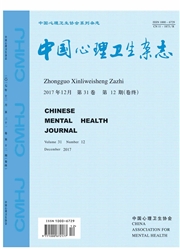

 中文摘要:
中文摘要:
目的:探讨重度抑郁症患者对负性情绪面孔的注意偏向。方法:从35名符合中国精神疾病诊断与分类手册第三版(CCMD-3)抑郁症诊断标准的被试中,筛选出符合汉密尔顿抑郁量表(Hamilton Depression Scale,HAMD)及Beck抑郁自评问卷(Beck Depression Inventory,BDI)重度抑郁症诊断标准的重度抑郁症患者(抑郁组)20名。选取在年龄、性别及受教育程度方面与抑郁组相匹配的正常对照20名。采用NimStim情绪面孔图片库中的负性情绪面孔和中性情绪面孔作为刺激材料,应用注意偏向研究中常用的线索一靶子任务进行研究,比较两组被试线索效应、注意施加、注意解除得分。结果:抑郁组对负性情绪面孔线索效应得分大于对中性情绪面孔线索效应得分(21.73msvs.3.91ms,P〈0.01);抑郁组注意施加得分大于对照组(17.25msvs.1.64ms,P〈0.001);对照组与抑郁组注意解除得分差别无统计学意义(-1.50msvs.0.57ms,P〉0.05)。结论:抑郁症患者对负性情绪信息加工存在注意偏向,对负性情绪信息缺乏保护性偏向。
 英文摘要:
英文摘要:
Objective: To investigate the attentional bias for negative emotional facial expressions in major depressive disorder ( MDD ) . Methods: Twenty MDD participants were selected from a larger pool of patients ( n = 35 ), diagnosed as depression with the Chinese Classification and Diagnostic Criteria of Mental Disorders Version 3 ( CCMD-3 ), according to the Hamilton Depression Scale ( HAMD ) and Beck Depression Inventory ( BDI ) . And 20 non-depression control participants ( NC ) matched with MDD group on age, gender and education level. All participants completed an exogenous cueing task which consisted of two kinds of cue types ( valid and invalid trial ) and two kinds of face types ( neutral faces and negative faces ) . Results : Patients with MDD showed more larger cue validity effect for negative faces compared with neutral faces ( 21.73 ms vs. 3.91 ms, P 〈 0. 01 ) . They showed a stronger attentional engagement for negative faces in comparison with non-depressed participants ( 17. 25 ms vs. 1.64 ms, P 〈0. 001) . The NC group directed attention away from negative faces, more rapidly disengaging their attention compared with MDD, but the differences showed no significant ( - 1.50 ms vs. 0. 57 ms, P 〉 0. 05 ) . Conclusion: These results support the assumption that MDD is associated with attentional bias for negative information, and deficits protective bias for it.
 同期刊论文项目
同期刊论文项目
 同项目期刊论文
同项目期刊论文
 期刊信息
期刊信息
